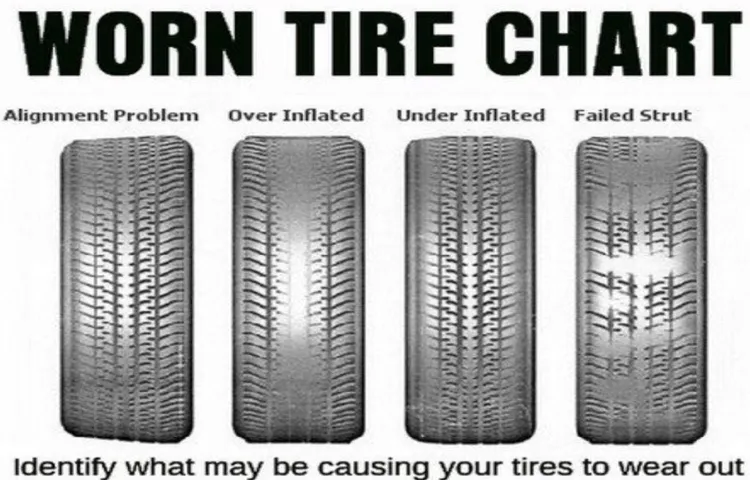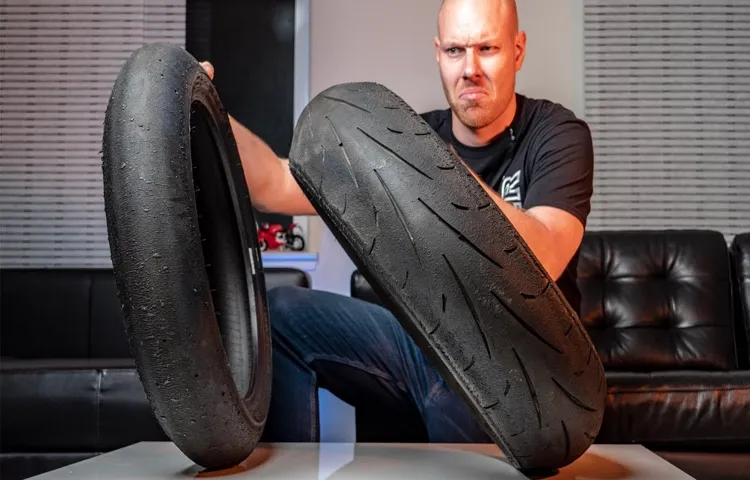Have you ever noticed your front tire leaning inwards when you park your bike? It’s a common occurrence that can be quite perplexing. If you have experienced this, then you might be wondering why is my front tire leaning in? Well, worry not! In this article, we will delve into this issue and provide you with a detailed explanation. Firstly, it’s essential to understand that bikes are designed to lean inwards slightly when parked.
This is because they have a “rake angle” that helps with stability when riding at higher speeds. However, if your front tire is leaning excessively, then there might be an underlying issue. One possible reason for your front tire leaning in could be an improperly adjusted front suspension.
If your suspension is too soft or too hard, it can cause your tire to lean in when parked. This can be fixed by adjusting the suspension to the manufacturer’s recommended settings. Another possibility could be a bent fork.
If you have been in an accident or hit a pothole, then your fork might be bent, causing your front tire to lean inwards. If this is the case, then you need to get your fork professionally inspected and fixed. Lastly, it could be a simple matter of uneven tire pressure.
If your front tire has lower pressure than the rear tire, it can cause your bike to lean in. Make sure to check your tire pressure regularly to avoid this issue. To sum it up, a front tire leaning in could be a sign of an issue with your suspension, fork or tire pressure.
It’s important to get to the bottom of the issue to ensure your safety while riding. By paying attention to your bike’s behavior and regularly maintaining it, you can prevent potential problems and enjoy a smooth ride.
Table of Contents
Possible Causes
If you’re wondering why your front tire is leaning in, it could be due to a number of different factors. One possibility is that the tire pressure is too low. If the tire is not properly inflated, it may appear to be leaning inwards.
Another possible cause is a misalignment of the wheel. If the wheel is not in proper alignment, it can cause the tire to tilt inward as well. Worn out suspension components can also cause this issue.
If the suspension is not functioning properly, it can lead to uneven wear on the tires, and cause them to lean inwards over time. Additionally, damaged steering parts may be to blame, as they can cause the tire to lean inwards if not functioning properly. To determine the cause of your leaning front tire, it’s important to get your vehicle inspected by a professional mechanic.
They can diagnose the issue and recommend the necessary repairs to get your vehicle back on the road safely and efficiently.
1. Wheel Alignment Issues
One of the most annoying problems we face while driving is when our car wheels don’t align properly. Misaligned wheels not only affect the vehicle’s handling but also the overall driving experience. While there are various reasons why your wheels might be out of alignment, the most common ones are worn-out suspension components, hitting potholes or curbs, and even regular wear and tear.
When suspension components wear out, it can result in a change in the car’s ride height, causing the wheels to become misaligned. Similarly, hitting potholes or curbs can result in bent rims or damaged suspension components. Regular wear and tear can also cause your wheels to become misaligned over time.
It’s essential to get your wheels checked periodically to avoid issues. If you notice any unusual vibrations or noises while driving, it’s necessary to get your wheels aligned immediately. Taking care of your car’s wheels is crucial for a smooth and safe driving experience.

2. Worn or Damaged Suspension Components
If you feel like your vehicle is bouncing too much, if it is difficult to handle while accelerating and braking, or if it makes an unusual sound when you turn or hit a bump, worn or damaged suspension components may be the culprit. It is often caused by general wear and tear or accidents. Additionally, weather and road conditions can take a toll on the suspension, leading to weakened components over time.
Overloading your vehicle beyond what its suspension can handle may also cause damage. It’s essential to have your suspension checked by a trusted mechanic regularly and address any issues promptly to avoid further damage. Neglecting to do so may result in more expensive repairs in the long run.
If you need to replace any components, always use high-quality, OEM parts to ensure proper function and longevity. Regular maintenance and care will help your suspension last longer and keep your vehicle running smoothly.
3. Low Tire Pressure
Low tire pressure is a common issue that many drivers face. There could be several possible causes for low tire pressure, such as damaged tires, punctures, valve stem issues, or simply due to a slow leak. A tire can lose air pressure over time due to various reasons, and it’s essential to get it diagnosed and fixed immediately.
Driving with low tire pressure can lead to decreased fuel efficiency, uneven wear and tear on the tires, and even blowouts. Ensuring that your tires are properly inflated not only improves your vehicle’s performance but also increases safety. One easy way to check your tire pressure is to use a tire pressure gauge, which can be found at any auto parts store.
Regular maintenance of your tires, including inflation, rotation, and alignment, can help prevent low tire pressure issues and ensure a smooth and safe driving experience. Taking care of your tires is crucial as they are the only thing that connects your vehicle to the road, and neglecting their maintenance can result in devastating consequences.
Effects of a Leaning Front Tire
If you’ve noticed your front tire leaning in, it’s important to get it fixed as soon as possible. There could be a few reasons why this is happening, but one of the most common is a problem with your front wheel bearings. Over time, these bearings can wear down and cause your tire to tilt inwards.
This can affect your steering and create a wobbling sensation when you ride. It’s also possible that your tire is simply out of alignment, which can happen if you hit a curb or pothole. In this case, a simple adjustment should fix the problem.
Whatever the cause, it’s important to address it quickly to ensure your safety on the road. If you’re unsure of what to do, it’s always best to consult a professional mechanic or bike shop.
1. Uneven Tire Wear
If you notice that your front tire is leaning to one side, it can cause some serious issues with your car’s performance. One of the main effects of a leaning front tire is uneven tire wear. This means that the tire will wear out more quickly on one side than the other, which can lead to a variety of issues.
For example, uneven tire wear can cause your car to pull to one side, making it harder to steer and control. Additionally, it can cause your car to vibrate or shake when driving, making for a less comfortable ride. To avoid these issues, it’s important to get your car inspected regularly and to fix any issues as soon as possible.
By addressing a leaning front tire and any resulting uneven wear, you can keep your car running smoothly and safely on the road.
2. Decreased Handling and Stability
A leaning front tire can significantly impact the handling and stability of your vehicle. The tire’s tilt, whether due to worn-out suspension or misalignment, alters the tire’s direct grip and can lead to inconsistent behavior on curves or uneven surfaces. As you drive, the leaning tire will generate uneven friction and weight distribution, causing you to feel vibrations, shaking, or drifting.
This can create an unsettling feeling for the driver and compromise the car’s response time, especially in emergency situations. Additionally, a leaning tire may cause uneven wear patterns and put stress on the suspension and steering components, leading to more severe and costly damages down the line. Therefore, it’s crucial always to inspect your tires and suspension and address any visible signs of a leaning tire right away to ensure a safe and comfortable driving experience.
3. Increased Risk of Accidents
When your front tire starts to lean, there can be serious consequences for your safety on the road. One of the most significant effects of a leaning tire is an increased risk of accidents. This is because a tire that leans too far can compromise your bike’s stability, making it difficult to control and keep on the road.
This can be especially dangerous when you’re turning or braking, as it can cause you to lose control and skid out. Furthermore, a leaning tire can also lead to uneven wear and tear, which can weaken the tire’s structural integrity and make it more prone to punctures or blowouts. That’s why it’s crucial to keep your tires properly aligned and maintained to ensure optimum safety and performance on the road.
Don’t risk a potentially life-threatening accident – get your tires checked regularly and take care of minor issues before they become major problems. Stay safe and enjoy the ride!
How to Fix a Leaning Front Tire
If you’re noticing that your front tire is leaning in, there’s likely an issue with either your tire or your wheel. The first thing you should do is check to make sure that your tire isn’t low on air. If it is, inflate it to the appropriate pressure.
If that doesn’t solve the issue, there may be something wrong with your wheel alignment. This could be caused by a variety of things, such as a bent rim or worn out tie rod ends. It’s important to get your wheel alignment checked by a professional if you suspect that this is the issue.
Ignoring a misaligned wheel can lead to uneven tire wear and other problems down the line. So, in summary, if you’re wondering why your front tire is leaning in, start by checking the tire pressure and move on to determining if there’s an issue with the wheel alignment.
1. Properly Inflate the Tire
Properly inflate your tire to fix a leaning front tire. This is often the culprit of a tire that leans to one side or the other. You can easily check your tire pressure by using a tire gauge or taking it to a local service station.
Be sure to check the manufacturer’s recommended pressure levels, as overinflated or underinflated tires can cause other issues like uneven wear and decreased fuel efficiency. In addition, it’s important to check your tire pressure regularly to ensure optimal performance and safety. By properly inflating your tire, you’ll not only fix the leaning issue but also improve your driving experience overall.
2. Check and Adjust Wheel Alignment
If you’re noticing that your front tire is leaning to one side, there could be a few different reasons why. One possible cause is that your wheel alignment is off. Over time, your tires can become misaligned from driving over bumps and potholes or even from hitting a curb.
To fix this, you’ll need to take your car to a mechanic or tire shop to have the alignment checked and adjusted. The process usually involves using specialized equipment to measure the angles of your wheels and making adjustments as needed. This will not only fix the leaning tire but can also help improve your car’s handling and prevent tire wear.
So, if you’re experiencing any issues with your tires or notice any unusual wear patterns, it’s always a good idea to have your wheel alignment checked by a professional.
3. Replace Worn or Damaged Suspension Components
If you’re dealing with a leaning front tire, it could be a sign that your suspension components are worn or damaged. The suspension system plays a crucial role in keeping your vehicle stable and on the road, and any issues with it should be addressed promptly. When dealing with a leaning tire, it’s best to start by inspecting the suspension components, including the shocks, springs, and struts.
If you notice any signs of wear, such as leaks or cracks, it’s time to replace them. Keep in mind that worn suspension components can cause uneven tire wear, poor handling, and even affect the overall safety of your vehicle. Investing in new suspension components is a small price to pay for the peace of mind that you and your passengers are safe on the road.
So, don’t hesitate to address any suspension issues and get your vehicle back on the road in top condition!
4. Seek Professional Help if Necessary
If you’re noticing that your front tire is leaning, it’s important to address the problem as soon as possible. Ignoring a leaning tire could lead to bigger issues down the road. One of the first things to check is the tire pressure.
Make sure the tire is properly inflated and adjust if necessary. If that doesn’t fix the problem, check the alignment and suspension. It’s possible that the tie rod ends or ball joints could be worn out, causing the tire to tilt.
If you’re not confident in diagnosing the issue yourself, it’s important to seek professional help. A mechanic can properly diagnose and fix the problem, ensuring your vehicle is safe to drive. Neglecting a leaning tire could cause damage to your vehicle and put you and others on the road in danger.
Don’t hesitate to get help if necessary.
Conclusion
Well, it seems your front tire has developed a mind of its own and decided it wants to lean in. It’s either feeling rebellious or just craving a little more attention. But alas, fear not! With the help of a qualified mechanic, we can get that tire back on track and teach it to behave.
After all, safety on the road is no laughing matter, unless we’re talking about the hilariously punny conclusion to this explanation.”
FAQs
Why is my front tire leaning in?
Your front tire may be leaning in due to a misaligned front wheel or worn-out steering components. It is important to get this fixed as soon as possible to avoid any safety hazards on the road.
How do I check if my front tire is misaligned?
You can check if your front tire is misaligned by observing the tire wear pattern. If there is uneven wear on the edges of the tire, it is a sign that the front tire is misaligned.
Can a misaligned front tire affect my car’s performance?
Yes, a misaligned front tire can affect your car’s performance by causing uneven tire wear, affecting the handling and steering, and reducing fuel efficiency.
How often should I check the alignment of my front tires?
It is recommended to check the alignment of your front tires every 6,000 to 8,000 miles or every six months, whichever comes first.
What should I do if my front tire is leaning in?
If your front tire is leaning in, you should take your car to a mechanic to get it checked and fixed. Ignoring this issue can result in poor handling, reduced fuel efficiency, and safety hazards on the road.
How much does it cost to fix a misaligned front tire?
The cost of fixing a misaligned front tire can vary depending on the severity of the issue and the make and model of your car. On average, it can cost anywhere between $50 to $200.
How long does it take to fix a misaligned front tire?
It typically takes around 1 to 2 hours to fix a misaligned front tire, but it can take longer if there are other issues with the steering or suspension components.



